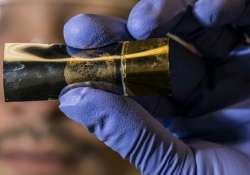Soon, a battery for your phone sans lithium!
New York: Call it a battery or a supercapacitor, researchers have now created a thin film for energy storage that combines the best qualities of a high-energy battery and a high-powered supercapacitor without the lithium

New York: Call it a battery or a supercapacitor, researchers have now created a thin film for energy storage that combines the best qualities of a high-energy battery and a high-powered supercapacitor without the lithium found in commercial batteries today.
“It behaves like a battery but the structure is that of a supercapacitor,” Yang Yang, postdoctoral researcher at Rice University in the US.
“If we use it as a supercapacitor, we can charge quickly at a high current rate and discharge it in a very short time. But for other applications, we find we can set it up to charge more slowly and to discharge slowly like a battery,” Yang explained.
The researchers developed the flexible material with nanoporous nickel-fluoride electrodes layered around a solid electrolyte to deliver battery-like supercapacitor performance.
The electrochemical capacitor is about a hundredth of an inch thick but can be scaled up for devices either by increasing the size or adding layers.
The square-inch device held 76 percent of its capacity over 10,000 charge-discharge cycles and 1,000 bending cycles.
The findings of the research appeared in the Journal of the American Chemical Society.
“It behaves like a battery but the structure is that of a supercapacitor,” Yang Yang, postdoctoral researcher at Rice University in the US.
“If we use it as a supercapacitor, we can charge quickly at a high current rate and discharge it in a very short time. But for other applications, we find we can set it up to charge more slowly and to discharge slowly like a battery,” Yang explained.
The researchers developed the flexible material with nanoporous nickel-fluoride electrodes layered around a solid electrolyte to deliver battery-like supercapacitor performance.
The electrochemical capacitor is about a hundredth of an inch thick but can be scaled up for devices either by increasing the size or adding layers.
The square-inch device held 76 percent of its capacity over 10,000 charge-discharge cycles and 1,000 bending cycles.
The findings of the research appeared in the Journal of the American Chemical Society.